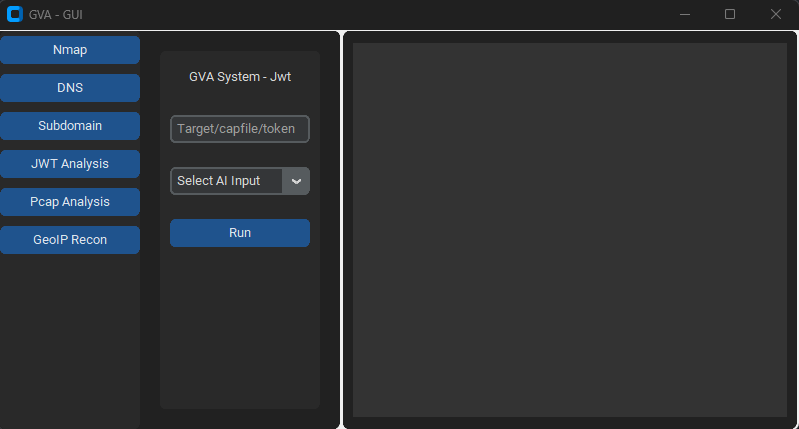https://github.com/morpheuslord/gpt_vuln-analyzer
Uses ChatGPT API, Bard API, and Llama2, Python-Nmap, DNS Recon, PCAP and JWT recon modules and uses the GPT3 model to create vulnerability reports based on Nmap scan data, and DNS scan information. It can also perform subdomain enumeration to a great extent
https://github.com/morpheuslord/gpt_vuln-analyzer
ai-vulnerability-analysis bard-ai bard-api chatgpt chatgpt-api dns dns-enumeration dns-enumeration-ai dns-record hacking-tools information-gathering llama2 nmap nmap-api nmap-vulnerability nmap-vulnerability-analysis-ai openai runpod terminal vulnerability-analysis
Last synced: 7 months ago
JSON representation
Uses ChatGPT API, Bard API, and Llama2, Python-Nmap, DNS Recon, PCAP and JWT recon modules and uses the GPT3 model to create vulnerability reports based on Nmap scan data, and DNS scan information. It can also perform subdomain enumeration to a great extent
- Host: GitHub
- URL: https://github.com/morpheuslord/gpt_vuln-analyzer
- Owner: morpheuslord
- License: mit
- Created: 2023-03-05T14:02:47.000Z (almost 3 years ago)
- Default Branch: main
- Last Pushed: 2024-11-09T12:45:33.000Z (about 1 year ago)
- Last Synced: 2025-04-07T21:09:07.782Z (8 months ago)
- Topics: ai-vulnerability-analysis, bard-ai, bard-api, chatgpt, chatgpt-api, dns, dns-enumeration, dns-enumeration-ai, dns-record, hacking-tools, information-gathering, llama2, nmap, nmap-api, nmap-vulnerability, nmap-vulnerability-analysis-ai, openai, runpod, terminal, vulnerability-analysis
- Language: Python
- Homepage:
- Size: 1.72 MB
- Stars: 540
- Watchers: 11
- Forks: 64
- Open Issues: 1
-
Metadata Files:
- Readme: README.md
- Contributing: CONTRIBUTING.md
- License: LICENSE
- Code of conduct: CODE_OF_CONDUCT.md
- Citation: CITATION.cff
- Security: SECURITY.md
Awesome Lists containing this project
- awesome-ChatGPT-repositories - GPT_Vuln-analyzer - Uses ChatGPT API, Python-Nmap, DNS Recon modules and uses the GPT3 model to create vulnerability reports based on Nmap scan data, and DNS scan information. It can also perform subdomain enumeration to a great extent (CLIs)
README
# GPT_Vuln-analyzer
This is a Proof Of Concept application that demostrates how AI can be used to generate accurate results for vulnerability analysis and also allows further utilization of the already super useful ChatGPT made using openai-api, python-nmap, dnsresolver python modules and also use customtkinter and tkinter for the GUI version of the code. This project also has a CLI and a GUI interface, It is capable of doing network vulnerability analysis, DNS enumeration and also subdomain enumeration.
## Requirements
- Python 3.10 or above
- All the packages mentioned in the requirements.txt file
- OpenAI API
- Bard API (MakerSuite Palm)
- Runpod serverless endpoint
- IPGeolocation API
- Docker
- Wireshark and tshark (both added to path)
## Usage Package
### Import packages
```bash
cd package && pip3/pip install .
```
Simple import any of the 3 packages and then add define the variables accordingly
```python
from GVA.scanner import NetworkScanner
from GVA.dns_recon import DNSRecon
from GVA.geo import geo_ip_recon
from GVA.jwt import JWTAnalyzer
from GVA.menus import Menus
from GVA.packet_analysis import PacketAnalysis
from GVA.ai_models import NMAP_AI_MODEL
from GVA.ai_models import DNS_AI_MODEL
from GVA.ai_models import JWT_AI_MODEL
from GVA.assets import Assets
from GVA.subdomain import sub_enum
from GVA import gui
# The components defined
dns_enum = DNSRecon()
geo_ip = geo_ip_recon()
p_ai_models = NMAP_AI_MODEL()
dns_ai_models = DNS_AI_MODEL()
port_scanner = NetworkScanner()
jwt_analizer = JWTAnalyzer()
sub_recon = sub_enum()
asset_codes = Assets()
packet_analysis = PacketAnalysis()
# KEEP IT BLANK IF YOU HAVE NO CLUE THE MENU WILL ASK TO FILL IT ONCE ACTIVE
lkey = "LLAMA API KEY"
lendpoint = "LLAMA ENDPOINT"
keyset = "AI API KEY"
output_loc = "OUTPUT LOCATION FOR PCAP"
threads = 200 # Default INT 200 but can be increased.
target_ip_hostname_or_token = "TARGET IP, HOSTNAME OR TOKEN"
profile_num = "PROFILE FOR NMAP SCAN"
ai_set = "AI OF CHOICE"
akey_set = "OPENAI API KEY"
bkey_set = "BARD API KEY"
ai_set_args = "" # Keep it blank at any cost
llamakey = "LLAMA RUNPOD API KEY"
llamaendpoint = "LLAMA RUNPOD ENDPOINT"
Menus(
lamma_key=lkey,
llama_api_endpoint=lendpoint,
initial_keyset=keyset,
threads=threads,
output_loc=output_loc,
target=target_ip_hostname,
profile_num=profile_num,
ai_set=ai_set,
openai_akey_set=akey_set,
bard_key_set=bkey_set,
ai_set_args=ai_set_args,
llama_runpod_key=llamakey,
llama_endpoint=llamaendpoint
)
gui.application()
```
`update for passcracker in the package and gui is still in progress.`
## Usage CLI
- First Change the "OPENAI_API_KEY", "GEOIP_API_KEY" and "BARD_API_KEY" part of the code with OpenAI api key and the IPGeolocation API key in the `.env` file
- For the `llama-api` option or specific the llama runpod serverless endpoint deployment option requires you to enter the `serverless endpoint ID` from runpod and also your `RUNPOD API KEY`
```python
GEOIP_API_KEY = ''
OPENAI_API_KEY = ''
BARD_API_KEY = ''
RUNPOD_ENDPOINT_ID = ''
RUNPOD_API_KEY = ''
```
- second install the packages
```bash
pip3 install -r requirements.txt
or
pip install -r requirements.txt
```
- Run the code python3 gpt_vuln.py
```bash
# Regular Help Menu
python gpt_vuln.py --help
# Rich Help Menu
python gpt_vuln.py --r help
# Specify target with the attack
python gpt_vuln.py --target --attack dns/nmap/jwt
# Specify target and profile for nmap
python gpt_vuln.py --target --attack nmap --profile <1-13>
(Default:1)
# Specify target for DNS no profile needed
python gpt_vuln.py --target --attack dns
# Specify target for Subdomain Enumeration no profile used default list file
python gpt_vuln.py --target --attack sub
# Specify target for Subdomain Enumeration no profile used custom list file
python gpt_vuln.py --target --attack sub --sub_list
# Specify target for geolocation lookup
python gpt_vuln.py --target --attack geo
# Specify PCAP file for packet analysis
python gpt_vuln.py --target --attack pcap --output --thread NUM of threads <200:default>
# Specify the AI to be used for nmap
python gpt_vuln.py --target --attack nmap --profile <1-5> --ai llama /llama-api /bard / openai
# Specify the AI to be used for dns
python gpt_vuln.py --target --attack dns --ai llama /llama-api /bard / openai
# Specify the AI to be used for JWT analysis
python gpt_vuln.py --target --attack jwt --ai llama /llama-api /bard / openai
# Password Cracker
python gpt_vuln.py --password_hash --wordlist_file --algorithm --parallel --complexity
# Interactive step by step cli interface
python gpt_vuln.py --menu True
```
#### CLI Interface Option
```bash
________________________
| GVA Usage in progress... |
========================
\
\
^__^
(oo)\_______
(__)\ )\/\
||----w |
|| ||
┏━━━━━━━━━┳━━━━━━━━━━━━━━━━┓
┃ Options ┃ Utility ┃
┡━━━━━━━━━╇━━━━━━━━━━━━━━━━┩
│ 1 │ Nmap Enum │
│ 2 │ DNS Enum │
│ 3 │ Subdomain Enum │
│ 4 │ GEO-IP Enum │
| 5 | JWT Analysis |
| 6 | PCAP Analysis |
| 6 | Hash Cracker |
│ q │ Quit │
└─────────┴────────────────┘
Enter your choice:
```
The CLI interface has a few things to note.
- The API keys must be provided manually.
- The ones defined in the `.env` files work with the args options
- The process is similar but more organized.
### My views on Bard
Its the same as Openai GPT3.5 but faster. It can generate the same answer but in 2 times the speed.
### OS Supported
| Preview | Code | Name | Working Status | OpenAI Status | Bard Status | LLama2 Status |
| -------------------------------------------------------------------------------------------------------------------- | ---- | --------- | -------------- | ------------- | ----------- | ----------------- |
| ") | LIN | GNU/Linux | ✅ | ✅ | ✅ | ❌ [did not test] |
| ") | WIN | Windows | ✅ | ✅ | ✅ | ✅ |
## Understanding the code
Profiles:
| Parameter | Return data | Description | Nmap Command |
| :-------- | :---------- | :--------------------------------------------------- | :---------------------------------------------------- |
| `p1` | `json` | Effective Scan | `-Pn -sV -T4 -O -F` |
| `p2` | `json` | Simple Scan | `-Pn -T4 -A -v` |
| `p3` | `json` | Low Power Scan | `-Pn -sS -sU -T4 -A -v` |
| `p4` | `json` | Partial Intense Scan | `-Pn -p- -T4 -A -v` |
| `p5` | `json` | Complete Intense Scan | `-Pn -sS -sU -T4 -A -PE -PP -PY -g 53 --script=vuln` |
| `p6` | `json` | Comprehensive Service Version Detection | `-Pn -sV -p- -A` |
| `p7` | `json` | Aggressive Scan with OS Detection | `-Pn -sS -sV -O -T4 -A` |
| `p8` | `json` | Script Scan for Common Vulnerabilities | `-Pn -sC` |
| `p9` | `json` | Intense Scan, All TCP Ports | `-Pn -p 1-65535 -T4 -A -v` |
| `p10` | `json` | UDP Scan | `-Pn -sU -T4` |
| `p11` | `json` | Service and Version Detection for Top Ports | `-Pn -sV --top-ports 100` |
| `p12` | `json` | Aggressive Scan with NSE Scripts for Vulnerabilities | `-Pn -sS -sV -T4 --script=default,discovery,vuln` |
| `p13` | `json` | Fast Scan for Common Ports | `-Pn -F` |
The profile is the type of scan that will be executed by the nmap subprocess. The Ip or target will be provided via argparse. At first, the custom nmap scan is run which has all the crucial arguments for the scan to continue. Next, the scan data is extracted from the huge pile of data driven by nmap. the "scan" object has a list of sub-data under "tcp" each labelled according to the ports opened. once the data is extracted the data is sent to the openai API Davinci model via a prompt. the prompt specifically asks for a JSON output and the data also to be used in a certain manner.
The entire structure of request that has to be sent to the openai API is designed in the completion section of the Program.
```python
class NetworkScanner():
profile_arguments = {
1: '-Pn -sV -T4 -O -F',
2: '-Pn -T4 -A -v',
3: '-Pn -sS -sU -T4 -A -v',
4: '-Pn -p- -T4 -A -v',
5: '-Pn -sS -sU -T4 -A -PE -PP -PY -g 53 --script=vuln',
6: '-Pn -sV -p- -A',
7: '-Pn -sS -sV -O -T4 -A',
8: '-Pn -sC',
9: '-Pn -p 1-65535 -T4 -A -v',
10: '-Pn -sU -T4',
11: '-Pn -sV --top-ports 100',
12: '-Pn -sS -sV -T4 --script=default,discovery,vuln',
13: '-Pn -F'
}
def scanner(self, ip: Optional[str], profile: int, akey: Optional[str],
bkey: Optional[str], lkey, lendpoint, AI: str) -> str:
nm.scan(ip, arguments=self.profile_arguments.get(profile))
json_data = nm.analyse_nmap_xml_scan()
analyze = json_data["scan"]
try:
ai_methods = {
'openai': lambda: AIModels.GPT_AI(akey, analyze),
'bard': lambda: AIModels.BardAI(bkey, analyze),
'llama': lambda: AIModels.Llama_AI(analyze, "local", lkey, lendpoint),
'llama-api': lambda: AIModels.Llama_AI(analyze, "runpod", lkey, lendpoint)
}
if AI in ai_methods and (akey or bkey):
response = ai_methods[AI]()
else:
raise ValueError("Invalid AI type or missing keys")
except KeyboardInterrupt:
print("Bye")
quit()
return str(response)
```
# Regex
We use Regex to extract only the important information from the custom prompt provided this reduces the total amount of unwanted
data
The AI code defines an output format and commands the AI to follow a few pre-determined rules to increase accuracy.
The regex extraction code does the extraction and further the main function arranges them into tables.
## Using Bard AI
For you to use Bard AI you must sign up to the MakerSuit Palm API for developer access and generate your API key from there. For links and how this works you can use this video [MakerSuit](https://www.youtube.com/watch?v=Ce1AOchQMzA&t=128s)
Once the API is acquired just add it to the `.env` file and you are good to go.
## Old LLama2 Implementation
Using LLama2 is one of the best offline and free options out there. It is currently under improvement I am working on a prompt that will better incorporate cybersecurity perspective into the AI.
I have to thank **@thisserand** and his [llama2_local](https://github.com/thisserand/llama2_local) repo and also his YT video [YT_Video](https://youtu.be/WzCS8z9GqHw). They were great resources. To be frank the llama2 code is 95% his, I just yanked the code and added a Flask API functionality to it.
The Accuracy of the AI offline and outside the codes test was great and had equal accuracy to openai or bard but while in code it was facing a few issues be because of the prompting and all. I will try and fix it.
The speed depends on your system and the GPU and CPU configs you have. currently, it is using the `TheBloke/Llama-2-7B-Chat-GGML` model and can be changed via the `portscanner` and `dnsrecon` files.
For now, the llama code and scans are handled differently. After a few tests, I found out llama needs to be trained a little to operate like how I intended it to work so it needs some time. Any suggestions on how I can do that can be added to the discussions of this repo [Discussions Link](https://github.com/morpheuslord/GPT_Vuln-analyzer/discussions). For now, the output won't be a divided list of all the data instead will be an explanation of the vulnerability or issues discovered by the AI.
The prompt for the model usage looks like this:
```prompt
[INST] <> {user_instruction}<> NMAP Data to be analyzed: {user_message} [/INST]
```
The instructions looks like this:
```prompt
Do a NMAP scan analysis on the provided NMAP scan information. The NMAP output must return in a asked format accorging to the provided output format. The data must be accurate in regards towards a pentest report.
The data must follow the following rules:
1) The NMAP scans must be done from a pentester point of view
2) The final output must be minimal according to the format given.
3) The final output must be kept to a minimal.
4) If a value not found in the scan just mention an empty string.
5) Analyze everything even the smallest of data.
6) Completely analyze the data provided and give a confirm answer using the output format.
7) mention all the data you found in the output format provided so that regex can be used on it.
8) avoid unnecessary explaination.
9) the critical score must be calculated based on the CVE if present or by the nature of the services open
10) the os information must contain the OS used my the target.
11) the open ports must include all the open ports listed in the data[tcp] and varifying if it by checking its states value. you should not negect even one open port.
12) the vulnerable services can be determined via speculation of the service nature or by analyzing the CVE's found.
The output format:
critical score:
- Give info on the criticality
"os information":
- List out the OS information
"open ports and services":
- List open ports
- List open ports services
"vulnerable service":
- Based on CVEs or nature of the ports opened list the vulnerable services
"found cve":
- List the CVE's found and list the main issues.
```
Using the instruction set and the data provided via the prompt the llama AI generates its output.
For the most usage I suggest you create a runpod serverless endpoint deployment of llama you can refer to this tutorial for that [tutorial](https://www.youtube.com/watch?v=Ftb4vbGUr7U). You can follow the tutorial for better use.
### Llama2 Ollama
This latest update uses an ollama docker image to implement the localized llama system and this increases the accuracy of the output for some reason maybe due to better configuration or something. I won't go into much detail about this but I will be working on the GPU integration part of the code for this so that we can add GPU power to the processing and make it more efficient. Thanks to @andr6 for starting the discussion, if anyone has a better understanding of this implementation feel free to improvise and create a PR.
### Output
#### JWT Output:
```
GVA Report for JWT
┏━━━━━━━━━━━━━━━━━━━━━┳━━━━━━━━━━━━━━━━━━━━━━━━━━━━━━━━━━━━━━━━━━━━━━━━━━━━━━━━━━━━━━━━━━━━━━━━━━━━━━━━━━┓
┃ Variables ┃ Results ┃
┡━━━━━━━━━━━━━━━━━━━━━╇━━━━━━━━━━━━━━━━━━━━━━━━━━━━━━━━━━━━━━━━━━━━━━━━━━━━━━━━━━━━━━━━━━━━━━━━━━━━━━━━━━┩
│ Algorithm Used │ HS256 │
│ Header │ eyJhbGciOiAiSFMyNTYiLCAidHlwIjogIkpXVCJ9 │
│ Payload │ eyJzdWIiOiAiMTIzNDU2Nzg5MCIsICJuYW1lIjogIkpvaG4gRG9lIiwgImlhdCI6IDE1MTYyMzkwMjJ9 │
│ Signature │ │
│ PossibleAttacks │ None identified │
│ VulnerableEndpoints │ Unable to determine without additional information │
└─────────────────────┴──────────────────────────────────────────────────────────────────────────────────┘
```
#### Nmap output:
##### OpenAI and Bard:
```table
┏━━━━━━━━━━━━━━━━━━━━┳━━━━━━━━━━━━━━━━━━━━━━━━━━━━━━━━━━━━━━━━━━━━━━━━━━━━━┓
┃ Elements ┃ Results ┃
┡━━━━━━━━━━━━━━━━━━━━╇━━━━━━━━━━━━━━━━━━━━━━━━━━━━━━━━━━━━━━━━━━━━━━━━━━━━━┩
│ critical score │ High │
│ os information │ Microsoft Windows 11 21H2 │
│ open ports │ 80, 22, 445, 902, 912 │
│ open services │ http, ssh, microsoft-ds, vmware-auth, vmware-auth │
│ vulnerable service │ OpenSSH │
│ found cve │ CVE-2023-28531 │
└────────────────────┴─────────────────────────────────────────────────────┘
```
##### LLama2
```table
╭───────────────────────────────────────────── The GVA LLama2 ──────────────────────────────────────────────╮
│ │
│ │
│ │
│ Based on the provided NMAP data, I have conducted a thorough analysis of the target system's open ports │
│ and services, vulnerabilities, and operating system information. Here is my findings: Critical Score: │
│ The critical score for this target system is 7 out of 10. The system has several open ports that could │
│ potentially be exploited, including port 80 (HTTP), port 135 (RPC), and port 445 (Microsoft DS). While │
│ These ports are not necessarily vulnerable, they do indicate that the system is running services that │
│ could be targeted by attackers. Additionally, the system has an outdated version of Microsoft IIS │
│ running on port 80, which could be a potential vulnerability. OS Information: The target system is │
│ running Microsoft Windows 10 1607. Open Ports and Services: The target system has the following open │
│ ports: │
│ │
│ • Port 80: HTTP (Microsoft IIS httpd) │
│ • Port 135: RPC (Microsoft Windows RPC) │
│ • Port 445: Microsoft DS │
│ • Port 8000: Splunkd httpd All of these ports are currently open and have a state of "open". │
│ Vulnerable Services: Based on the CVEs found in the NMAP data, there are several potential │
│ vulnerabilities in the target system's services. These include: │
│ • CVE-2019-1489: An elevation of privilege vulnerability in Microsoft IIS that could be exploited by │
│ an attacker to gain control of the system. This vulnerability is related to the outdated version of │
│ Microsoft IIS running on port 80. │
│ • CVE-2017-0143: A remote code execution vulnerability in Microsoft Windows RPC that could be │
│ exploited by an attacker to execute arbitrary code on the target system. This vulnerability is │
│ related to the outdated version of Microsoft Windows RPC running on port 135. │
│ • CVE-2020-1362: A remote code execution vulnerability in Microsoft DS that could be exploited by an │
│ attacker to execute arbitrary code on the target system. This vulnerability is related to the │
│ outdated version of Microsoft DS running on port 445. Found CVEs: The following C │
│ │
╰───────────────────────────────────────────────────────────────────────────────────────────────────────────╯
```
#### DNS Output:
target is jainuniversity.ac.in
```table
┏━━━━━━━━━━┳━━━━━━━━━━━━━━━━━━━━━━━━━━━━━━━━━━━━━━━━━━━━━━━━━━━━━━━━━━━━━━━━━━━━━━━━━━━━━━━━━━━━━━━━━━━━━━━━━━━━━━━━━━━━━━━━━━━┓
┃ Elements ┃ Results ┃
┡━━━━━━━━━━╇━━━━━━━━━━━━━━━━━━━━━━━━━━━━━━━━━━━━━━━━━━━━━━━━━━━━━━━━━━━━━━━━━━━━━━━━━━━━━━━━━━━━━━━━━━━━━━━━━━━━━━━━━━━━━━━━━━━┩
│ A │ 172.67.147.95", "104.21.41.132 │
│ AAA │ │
│ NS │ mia.ns.cloudflare.com.","paul.ns.cloudflare.com. │
│ MX │ 30 aspmx5.googlemail.com.","30 aspmx4.googlemail.com.","20 alt2.aspmx.l.google.com.","30 │
│ │ aspmx3.googlemail.com.","30 aspmx2.googlemail.com.","20 alt1.aspmx.l.google.com.","10 aspmx.l.google.com. │
│ PTR │ │
│ SOA │ mia.ns.cloudflare.com. dns.cloudflare.com. 2309618668 10000 2400 604800 3600 │
│ TXT │ atlassian-sending-domain-verification=5b358ce4-5ad3-404d-b4b4-005bf933603b","include:_spf.atlassian.net │
└──────────┴───────────────────────────────────────────────────────────────────────────────────────────────────────────────────┘
```
#### GEO Location output:
```table
┏━━━━━━━━━━━━━━━━━━━━━━━━━━━━━┳━━━━━━━━━━━━━━━━━━━━━━━━━━━━━━━━━━━━━━━━━━━━━━━━━━━━━━━━━━━━━━━━━━━━━━━━━┓
┃ Identifiers ┃ Data ┃
┡━━━━━━━━━━━━━━━━━━━━━━━━━━━━━╇━━━━━━━━━━━━━━━━━━━━━━━━━━━━━━━━━━━━━━━━━━━━━━━━━━━━━━━━━━━━━━━━━━━━━━━━━┩
│ ip │ █████████████ │
│ continent_code │ AS │
│ continent_name │ Asia │
│ country_code2 │ IN │
│ country_code3 │ IND │
│ country_name │ India │
│ country_capital │ New Delhi │
│ state_prov │ Haryana │
│ state_code │ IN-HR │
│ district │ │
│ city │ Gurugram │
│ zipcode │ 122003 │
│ latitude │ 28.44324 │
│ longitude │ 77.05501 │
│ is_eu │ False │
│ calling_code │ +91 │
│ country_tld │ .in │
│ languages │ en-IN,hi,bn,te,mr,ta,ur,gu,kn,ml,or,pa,as,bh,sat,ks,ne,sd,kok,doi,mni,… │
│ country_flag │ https://ipgeolocation.io/static/flags/in_64.png │
│ geoname_id │ 9148991 │
│ isp │ Bharti Airtel Limited │
│ connection_type │ │
│ organization │ Bharti Airtel Limited │
│ currency.code │ INR │
│ currency.name │ Indian Rupee │
│ currency.symbol │ ₹ │
│ time_zone.name │ Asia/Kolkata │
│ time_zone.offset │ 5.5 │
│ time_zone.current_time │ 2023-07-11 17:08:35.057+0530 │
│ time_zone.current_time_unix │ 1689075515.057 │
│ time_zone.is_dst │ False │
│ time_zone.dst_savings │ 0 │
└─────────────────────────────┴─────────────────────────────────────────────────────────────────────────┘
```
#### PCAP OUTPUT
```
Collecting Json Data
Extracting IP details...
Extracting DNS details...
Extracting EAPOL details...
Extracting TCP STREAMS details...
TCP streams can take some time..
Total Streams combination: 252
Number of workers in progress: 250
Completed
GVA Report for PCAP
┏━━━━━━━━━━━━━━━━━━━━━━━━━━━━━━━━━━━━┳━━━━━━━━━━━━━━━━━━━━━━━━━━━━━━━━━━━━━━━━━━━━━━━━━━━━━━━━━━━━━━━━━━━━━━━━━━━━━━━━━━━━━━━━━━━━━━━━━━━━┓
┃ Identifiers ┃ Data ┃
┡━━━━━━━━━━━━━━━━━━━━━━━━━━━━━━━━━━━━╇━━━━━━━━━━━━━━━━━━━━━━━━━━━━━━━━━━━━━━━━━━━━━━━━━━━━━━━━━━━━━━━━━━━━━━━━━━━━━━━━━━━━━━━━━━━━━━━━━━━━┩
│ PacketAnalysis.Services │ ['49943', '49958', '49934', '49944', '49931', '443', '49957'] │
│ PacketAnalysis.TCP Streams │ ['1', '4', '5', '2', '0', '3'] │
│ PacketAnalysis.Sources Address │ ['█████████████', '1.1.1.1', '█████████████', '█████████████', '█████████████', '█████████████'] │
│ PacketAnalysis.Destination Address │ ['█████████████', '1.1.1.1', '█████████████', '█████████████', '█████████████', '█████████████'] │
│ PacketAnalysis.DNS Resolved │ [] │
│ PacketAnalysis.DNS Query │ ['oneclient.sfx.ms'] │
│ PacketAnalysis.DNS Response │ ['oneclient.sfx.ms.edgekey.net', 'e9659.dspg.akamaiedge.net', 'oneclient.sfx.ms'] │
│ PacketAnalysis.EAPOL Data │ [] │
│ PacketAnalysis. Total Streams Data │ 126 │
└────────────────────────────────────┴────────────────────────────────────────────────────────────────────────────────────────────────────┘
```
#### Password Cracker Output
```
________________________
| GVA Usage in progress... |
========================
\
\
^__^
(oo)\_______
(__)\ )\/\
||----w |
|| ||
Cracking... ━━━━━━━━━━━━━━━━━━━━━━━━━━━━━━━━━━━━━━━━ 100% 0:00:00
╭────────────────────────────────────────────── The GVA Password Cracker ──────────────────────────────────────────────╮ │ │ │ │
│ Password Cracked! Password: legion │
│ │
╰───────────────────────────────────────────────────────────────────────────────────────────────────────────────────────╯
```
# Usage GUI
The GUI uses customtkinter for the running of the code. The interface is straightforward the only thing required to remember is:
- When using dns attack don't specify the profile
```bash
python GVA_gui.py
```
### Initial window
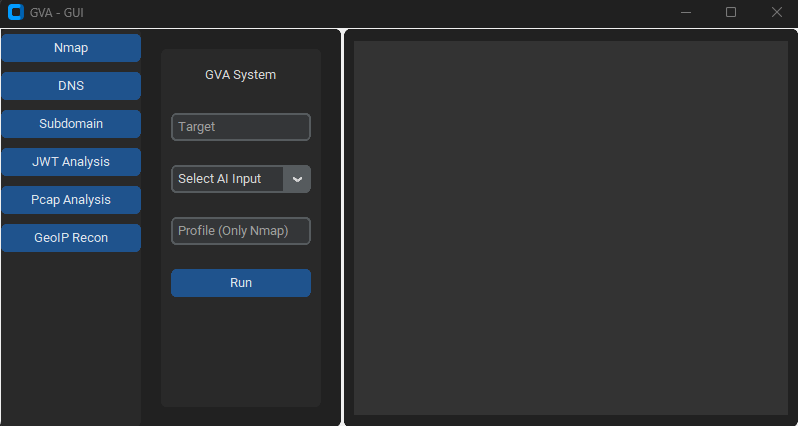
### NMAP window
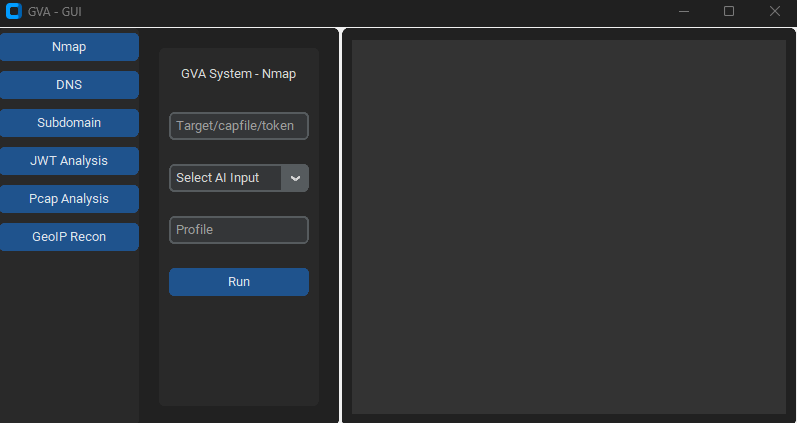
### DNS window
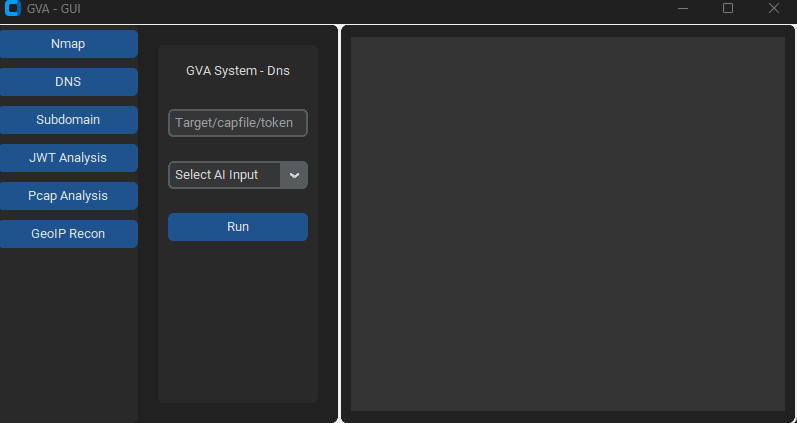
### GEOIP window
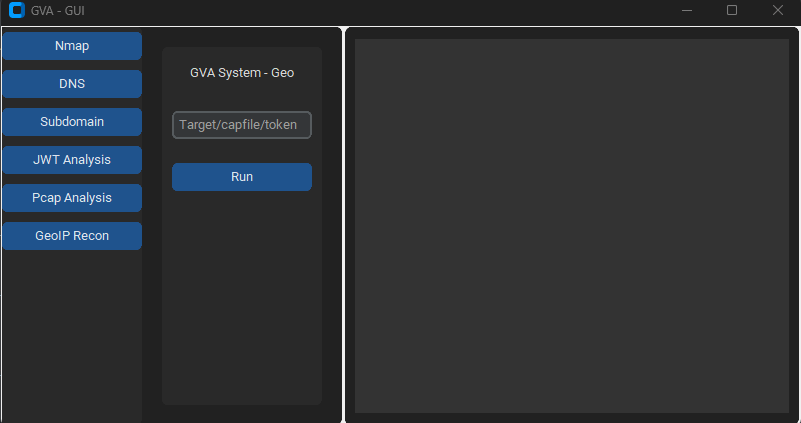
### PCAP window
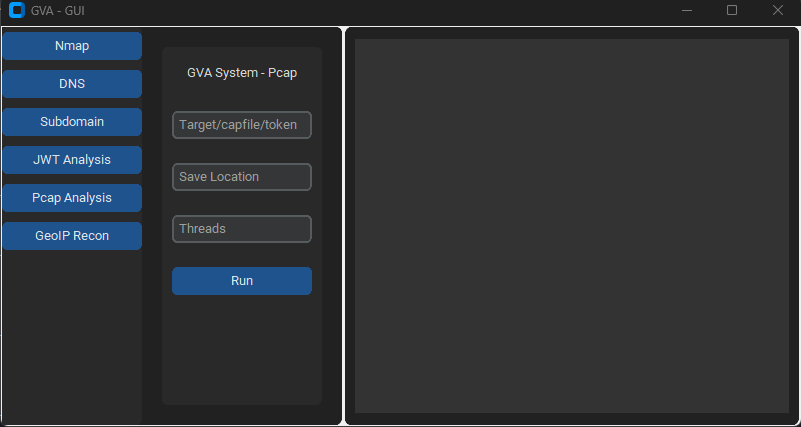
### SUBDOMAIN window
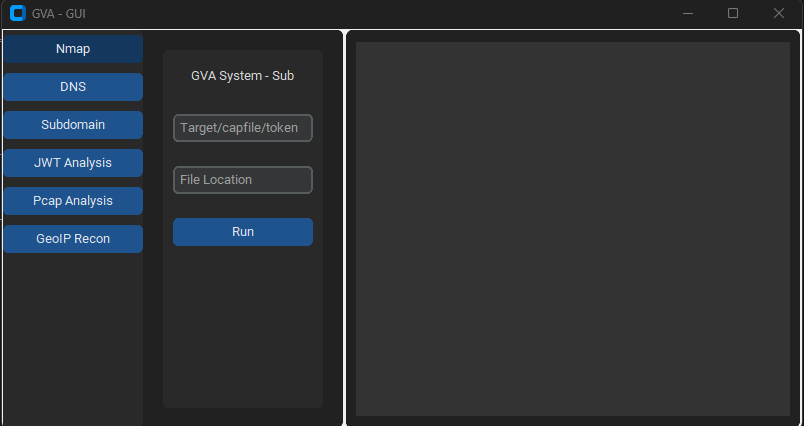
### JWT window
